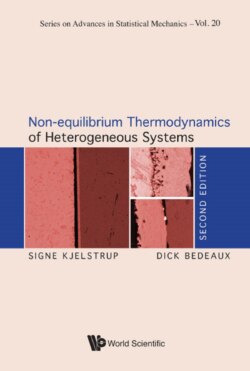Читать книгу Non-equilibrium Thermodynamics of Heterogeneous Systems - Signe Kjelstrup - Страница 7
ОглавлениеPreface of the second edition
Aim of the book
The aim of our book is to prescribe how consistent thermodynamic models can be achieved for heterogeneous systems. Such models are, for instance, in demand in electrochemical research. The first edition presented and discussed several examples, among them evaporation and condensation, fuel cells, thermoelectricity, and thermal osmosis. This edition adds two new chapters. Since the publication of the first edition, the analysis of a dynamic phase transition has been brought to the next stage [1]. It is therefore natural in this second edition to add a chapter on the effect of curvature on interface transfer coefficients. The new chapter (Chapter 24) deals with this.
An hitherto unexplored feature, that follows from the entropy production in heterogeneous systems, is its prediction for reaction kinetics. Chemical reaction kinetics is a well-established field, and the law of mass action is well understood, also from a thermodynamic point of view [2]. Chapter 25 describes how the rate law can be affected in heterogeneous catalysis, by coupling to other driving forces, leading to new explanations of Arrhenius plots.
In the first 23 chapters, we have corrected misprints. New references have been introduced in the context of the new chapters.
Teaching non-equilibrium thermodynamics
Since the first edition was published about 10 years ago, there has been an increased interest in the use non-equilibrium thermodynamics. The current focus on energy efficiency as an important design parameter in engineering is creating a demand for better teaching of thermodynamics. The theory of non-equilibrium thermodynamics offers a precise determination of the entropy production. We co-authored a textbook, Non-equilibrium Thermodynamics for Engineers [3], which was revised in 2017 [2], useful for such a purpose.
Acknowledgments for the second edition
We appreciate discussions and collaborations with colleagues (in alphabetical order) Daniel Barragan, Carolina Cruz, Anders Lervik, Elisa Magnanelli, and Øivind Wilhelmsen.
The authors are especially grateful to the Research Council of Norway, through its Centers of Excellence funding scheme, project number 262644, PoreLab.
Facultad de Ciencias of Universidad Nacional de Colombia Sede Medellin partially supported the work in Chapter 25 with the grant QUIPU 201010021328.
| January 2020 | Signe Kjelstrup and Dick Bedeaux |
